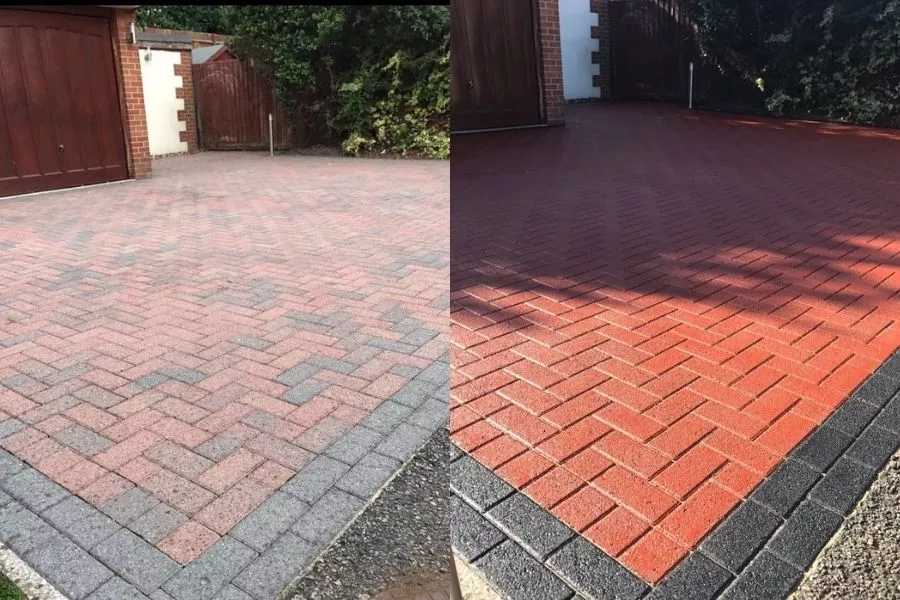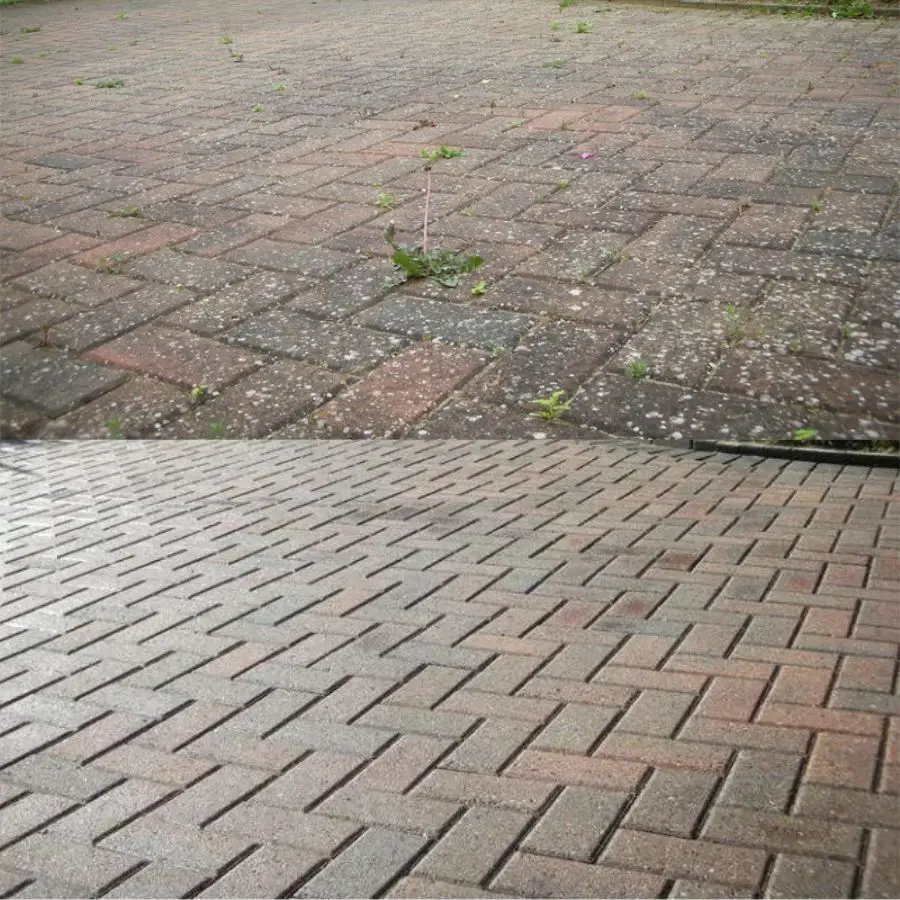How to Re-sand & Seal Block Paving? (Step by Step Guide)

Re-sanding and sealing block paving go hand in hand. If you get this process correct, you’re going to protect your block paving for the next 2 to 3 years in terms of stability and appearance until it’s time to re-sand and seal again.
However, if you don’t do it properly, chances are it’ll need to be re-sanded and re-sealed much before the time than it should. Also, the harm it’s going to do to the block paving in that time frame is different. Hence, the proper care of the investment that you’ve made in the form of block paving is crucial for its longevity.
So without wasting any time, let’s begin straight with the first step of the most important step in the process of re-sanding and sealing block paving driveway.
You can clean and re-sand on any clear day throughout the year. However, the most ideal time to seal a block paved driveway is in the beginning of summer onwards. Hence, most driveways are cleaned, re-sanded, and sealed in summer to get everything done at once.
Why cleaning is important before re-sanding & sealing?
Before sanding and sealing, cleaning the block paving is a must thing that needs to be done. By the block paving, it doesn’t mean only the upper surface but also the joints where the new kiln-dried sand will go.
You could use a tool something like this one here on Amazon to clean the joints and make them ready for the new sand to go in.
Cleaning block paving makes it ready for re-sanding and sealing because you take all the unnecessary muck away from your driveway and makes it ready to have necessary things like sand and sealer that are actually going to protect your driveway or block paving.
If you haven’t pressure-washed your block paving for a couple of years now, there is a strong chance that you need to pressure clean it with a pressure washer because there might be all sorts of things grown and stuck on the pavers over the years.
Time Required: Depends on how you’re willing to clean. Usually, it takes 3-4 hours with a pressure washer (non-DIY) for a decent size driveway like 100 square meters which is super untidy.
Cost to Hire Someone: It can be as low as £2/m2 and can even go up to £5/m2 depending on the firm. However, the price/m2 can drop if you have a bigger-sized driveway and sometimes you can also get re-sanding done with cleaning in that price range.
How to proceed with cleaning block paving?
Pressure washing can be the best way to clean the block paving quickly and effectively but make sure you don’t go very harsh with the pressure washer by using it at a very high setting. Pressure washer causes more damage to the block paving in less time than the normal wear and tear in our daily life.
There are all sorts of cleaning products available on the market today to make the cleaning process much easier. You need to spray the product on the paving, wait for an hour or so for the mosses and algae to die out automatically, and then it can be easily cleaned with a pressure washer.
Also, it’ll take a lot longer to clean the block paving if you’re using just the pressure of the water from the pressure washer.
I recommend getting this Essential Block Paving Cleaner from Stonecare4u. See the example video below to see how these cleaning products for pavings work.
It’s another type of cleaner for a different surface from the same brand, Stonecare4u but the process and the results shown in the video are the same for block paving.
You can get their cleaner specifically for block paving on their website here.
Re-sand
Re-sanding block paving every time you clean it is must because it’s what keeps the paving in place and prevents any movement or sinking in the paving. The block paving needs to be absolutely dry to re-sand and even seal.
If you are not in a hurry, it will be recommended that you should wait for a week before you re-sand and seal because then the water from the pressure washing that goes till the depth of the paving just completely gets out.
Step 1: Re-sanding Materials
Kiln Dried Sand
For sanding or re-sanding block paving, you need only and only kiln-dried sand. No other sand can do this for you. You need kiln-dried sand that’s absolutely bone dry, make sure there’s no moisture in the sand otherwise the sand isn’t easily going to flow into the joints.
There is this advanced type of jointing sand on the market which is much more resistant to weeds and probably will wash out less than the normal kiln-dried sand if you are not considering sealing at least for now because for this sand, you’ve to sprinkle water over it once you’re done sweeping and it’ll harden to some extent than just sitting into the joints of the paving.
It could be a little more expensive than the normal kiln-in dried but it is good stuff to use and worth it if you’ve let’s say a smaller area to cover. See its price and more details here.
However, you could also use normal kiln-dried sand for the most part, and use this special kind of sand in areas where you see most of the weeds growing.
The kiln-dried sand is mostly available in 20-25-kg bags and it costs between £5-£10 per bag depending on where you’re in the country. It can be picked up from any DIY store near you or your local merchant.
One bag (20-25 kg) of kiln-dried sand covers between 10-20 square meters so, according to the size of your block paving you can calculate approximately how much kiln-dried sand you need. However, it varies widely from paving to paving because of the size of joints and how much sand has been blasted out while cleaning with the pressure washer.
Again, as said earlier, before pouring the kiln-dried sand it’s very important the paving should be also dry. Otherwise, the sand will just clump and stick on the paving surface if it’s wet instead of going into the joints when brushed in. It’ll take a couple of hours for paving to dry and be completely water-free depending on the temperature.
Brush to sweep in the Sand
You’ll need a good long-handled sweeping brush or two to sweep in the kiln-dried sand into the joints of your block paving. A soft-bristled brush will far easily sweep the sand into the joints of the block paving without leaving much of it behind. Something like this one here on Amazon.
Later you could use any small hand-broom to sweep away the excess sand off the block paving after filling all the joints.
Many people have the doubt that why not just cement the joints of block paving or mix cement with kiln dried sand so it will never wash out. The reason is block paving needs to be flexible. In the UK, block paving is the most popular option for a driveway, and kiln-dried sand is the thing that goes into the joints of block paving.
Step 2: Start Re-sanding
Empty the total bag of sand on the paving. Pour the entire bag of kiln-dried sand in the same place, preferably choosing one side of the paving.
By pushing the sand with the brush forward in the joints, make sure the joint you’re filling is full with the sand and there’s not enough room for more sand.
Sweep in diagonally, not with the joints to make sure you’re not taking out the sand from the joints.
Seal
It’s time for the last step that needs to be done to ensure you’re going to fully protect your block paving for the next couple of years.
Choose a clear day for sealing by making sure the paving will stay dry after sealing for the next 24-48 hours which will allow the sealer to dry nicely and establish a good protective layer on top of your block pavers.
If possible. the best practice to follow would be to wait to seal the pavers for a day after cleaning them so, they’re completely dry when you seal them and ready to fully soak the sealer which is really important for its longevity.
Step 1: Cleaning sand off block paving
Prior to beginning sealing, the rest of the block paving except the joints that we just filled out needs to be free of kiln-dried sand. Also, there shouldn’t be any dust or leaves on the paving which may also get trapped under the sealer.
I said before, you could use a soft hand broom to sweep away the excess kiln-dried sand. Excess sand could be also swept or blown away with a leaf blower. Hold the blower far from the paving and go with a little horizontal position, not pointing the blower directly to the pavers so you don’t take out the sand from the joints too.
Step 2: Selecting right kind of sealer for your paving & its quantity
(At this stage, you have the option to restore the colour of your block or basically paint the block paving. If your block pavers are quite old and highly faded now, there’re products on the market that bring back the colour of your pavers without the need of replacing them with new ones. Check this post that I wrote to know more about the products that I’m talking about and much more details on restoring the colour of your block paving.)
Many people think that there are some special kinds of sealers available on the market to stop weeds in the block paving but it’s not true. No sealer is going to stop weeds from growing, except the regular maintenance of block paving.
There are a number of different options in the block paving sealers category to choose from for your paving. Any high-quality sealer specially designed for block paving should be fine if you choose what type of finish you want, whether glossy or matt.
The recommended sealer that you should use on your driveway is also from Stonecare4u. It’s a high-quality sealer that’s neither too glossy nor even just plain matt giving a naturally appealing satin finish to your driveway which looks attractive.
Check out the Stonecare4u Essential Block Paving Sealer on their website here.

Check here on their website for the available quantity options according to the size of your block paving as well as the price.
A liter of sealer covers around 2 square meters of 2 coats on block paving depending on your way of application. By keeping this approximate in mind, you can calculate how much sealer would be required for your particular size of paving. There are single-coat sealers available on the market, which should do basically double than 2 square meters per liter.
Sealing can be a little expensive if you have a decent size of block paving to seal because quality sealers aren’t cheap and hence most people with reasonably sized driveways don’t consider sealing, especially in the case of the old driveway. They get the pressure washing and re-sanding done by hiring someone and skipping on sealing but it’s actually that expensive.
Step 3: Equipment
After getting the sealer, you will require certain things to get that sealer on the block paving while making the job safer and easier.
One of them is a good roller. Of course, you can use a sprayer but rollers are mostly used for this purpose and it’s recommended to use a roller to get the sealer evenly on the surface to ensure that it will give the best protection. Even, some brands recommend applying their sealers only with rollers.
You’ll also need something to have the sealer in appropriate quantities to start sealing. If possible, pick up a paint scuttle with the other things which turns handy while doing the job. Consider using a roller with ‘double arm’ because it will not bend easily even if you apply some pressure while applying.
Also, keep a small paintbrush to cover the edges of the paving where it’s hard to take the roller and also to prevent unnecessary stains from the sealer on the wall or any other thing along the paving.
This combo here on Amazon includes a proper double arm roller which is what we want, a scuttle, and even a small paintbrush for the areas where sealing is not possible with the roller. See it here.
Consider wearing safety equipment like these given here while working with the sealer to ensure the best safety possible.
Step 4: Begin Sealing
How much sealer you’re supposed to apply on your block paving? 2 square meters per liter of sealer is a sweet spot to ensure that you’re creating a nice thick enough coat that’s going to protect your block paving really well.
Not on just the pavers but also focus on the joints because the sand in the joints should also be sealed. Meaning, that the sealer should go deep inside the joints so the sand gets in its place and hence the block paving. This is how you’re going to prevent the sand from washing out of the joints.
Looking for someone to do the right job? Enquire to the best contractor possible in your area
Just enter the details below and we will make sure to get back to you with the best in your area.
Two coats of sealer are a must unless you’re the sealer you’re using is a single-coat sealer that promises that a single coat of sealing could do the job. The second coat of the sealer can be applied a couple of hours later after the first coat has dried depending on the temperature.
The sealer can provide the results for more than a couple of years but to protect the paving to the fullest, it needs to be applied after every 2-3 years to keep the paving looking good and protect it as much as possible.
How much do block paving sealers cost?
A 100m2 driveway requires 50L of sealer to get its sealing done properly. A high-quality 50L sealer costs between £250-£300 (based on 2 x 25L each bucket of SmartSeal block paving high-quality sealer that costs £130 each) and the cost to hire somebody just seal that 100m2 driveway would be around £150.
How long does it take to seal a block paved driveway?
An average size block paved drive could be sealed in 2-4 hours. However, if the weather is not right, you might not be able to proceed with sealing the pavers until the weather clears.
How long after power washing block paving, can you seal it?
After cleaning the block paving, you could seal it once it completely dries out. However, the best practice would be to wait until the next day, even in normal weather conditions to get the most out of the sealer.
How long to leave block paving without using after sealing it?
Most sealers are recommended to leave at least 24 hours before using after the application. However, in wet conditions, it won’t hurt to leave it for another 24 hours.


“I found this article very informative about “”””. Looking forward for more informative articles like this related to Advanced Driveway Solutions
“
Very clear and very informative,Thanks
How do you clean a the block paving after its been sealed. For example the following year. I presume jet washing would just wash the sealant off again?
Yes, pressure washing would wash off the sealer to some extent if not completely depending on how you use the washer. The whole point of sealing a block paving is that it could be easy to maintain. So if you have properly sealed the paving, it should be easy to get rid of all the dirt without using the washer.
Pressure washing should be done when the drive is really dirty generally, every 2-3 years and the best practice is after you pressure wash, apply at least one coat of sealer to compensate for the loss of previous sealer.
Before sealing, I assume you have carried out a thorough cleaning which is very important.